Making homemade glazed doughnuts is easier than you think, but requires a little patience. Ready in about 2.5 hours, these taste like doughnuts from your favorite bakery, but they’re made in the comfort of your own home. For doughnut success, follow my step-by-step photos, helpful success tips, and video tutorial. Using this same doughnut dough, you can create other flavored frosted doughnuts too!
I originally published this recipe in 2016 and have since added new photos, a video tutorial, and more helpful success tips.
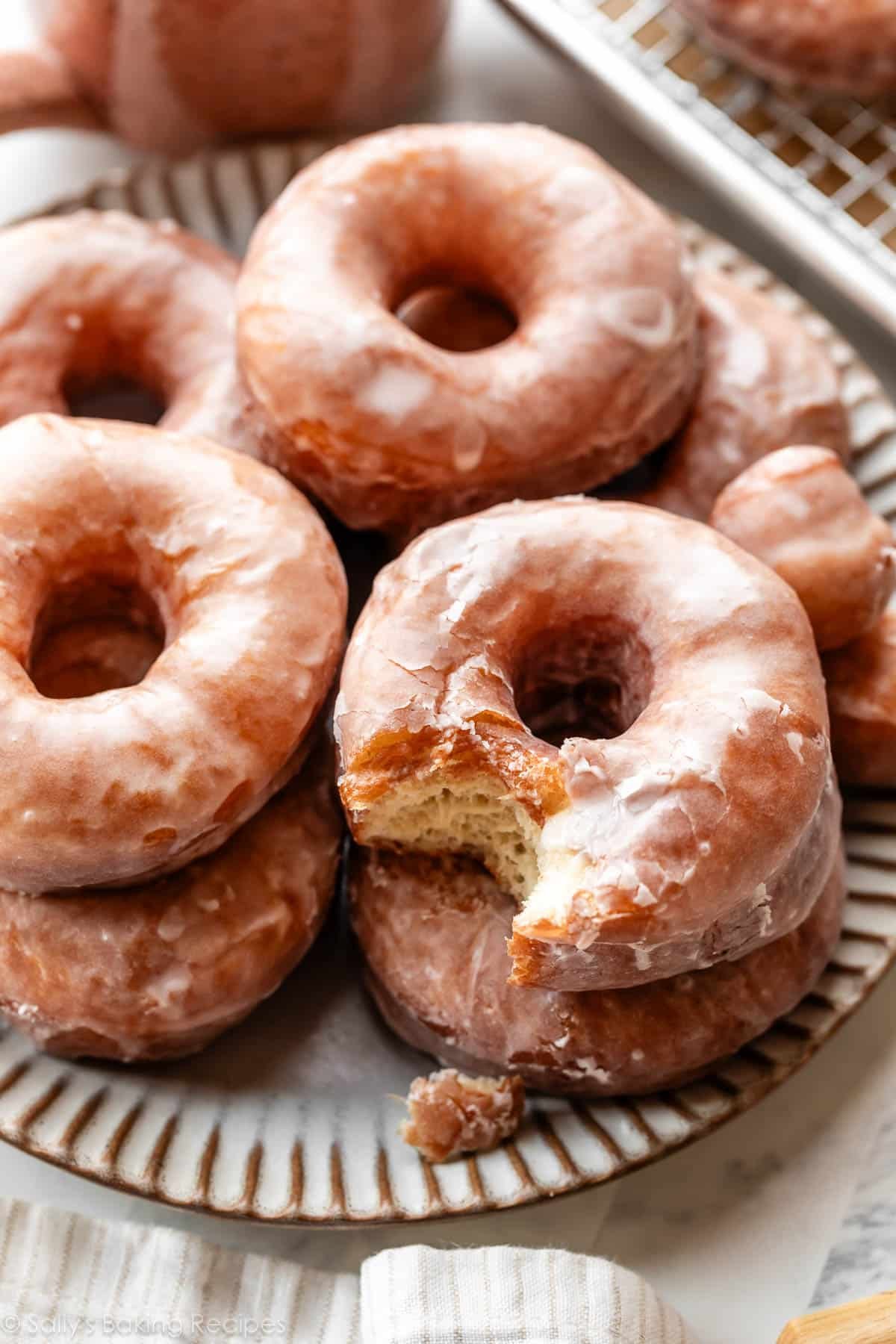
With that signature bakery taste and texture, doughnuts from a doughnut shop are incredibly delicious and indulgent. When you can’t pick up your favorite doughnuts, why not make them at home instead? They’ve always been a baking bucket list recipe for me, and today I’m taking you on a deep dive into homemade doughnuts—fried, sugary, old-fashioned, and comforting. I originally shared this recipe in 2016, and I now have more step-by-step photos and a video tutorial to guide you.
There’s a lot to cover today, so let’s get started!
These Homemade Glazed Doughnuts Are:
- Soft and sweet
- Flavored with a little nutmeg
- Completely from scratch
- Ready in about 2.5 hours (most of this is rise time!)
- A fun and delicious weekend project
- Perfect for sharing
One reader, Sue, commented: “I just made these doughnuts. I usually make my grandmother’s old fashioned doughnuts, but these may be my new favorite. These are absolutely perfect. Easy to make. They are a hit! Five stars all the way! ★★★★★“

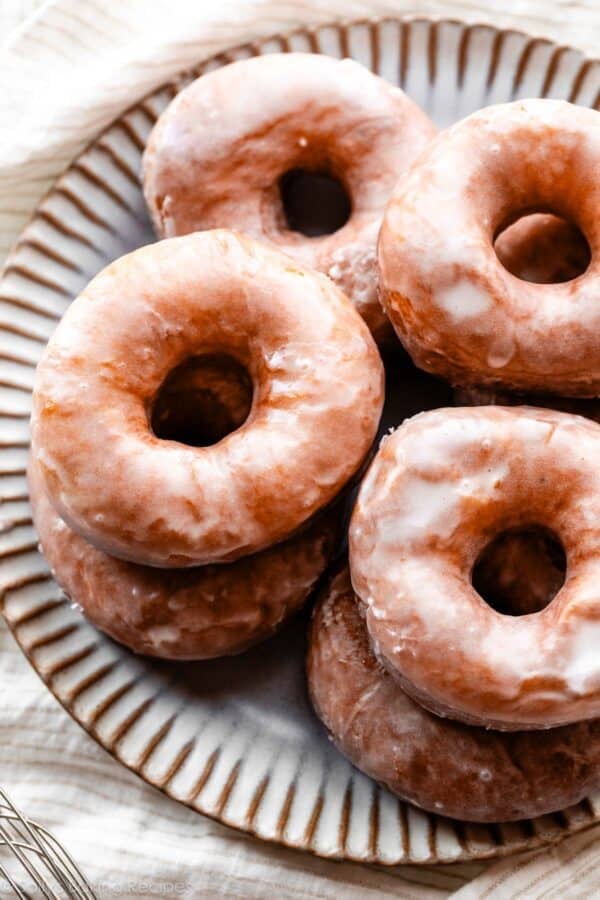
Best Ingredients to Use for Homemade Doughnuts
This is a straightforward, no-frills yeasted dough. You need just a few ingredients to begin:
- Milk: Liquid activates the yeast. Whole milk is a must for a super tender dough—or you can try buttermilk. Lower-fat or nondairy milks work in a pinch, but the doughnuts aren’t as flavorful or rich.
- Yeast: You can use active dry yeast or instant yeast. If using an instant yeast, your rise time will be a little shorter.
- Sugar: Sugar sweetens the doughnuts, but it also feeds the yeast, increases its activity, and tenderizes the dough.
- Eggs: Eggs provide structure and flavor.
- Butter: Melted butter promises enhanced flavor.
- Salt & Vanilla Extract: Both add flavor. You could even try using homemade vanilla extract!
- Nutmeg: A little nutmeg is the secret ingredient to that cozy, comforting bakery taste. If you’ve ever made my chocolate chip muffins, you know it adds a delicious pop of flavor!
- Flour: All-purpose flour is the dough’s structure. You’ll be tempted to add more and more flour as you mix the dough, but don’t. You want a very soft, pillowy dough for soft, pillowy doughnuts. The dough can still be slightly sticky. When kneading, use extra flour on your hands and work surface.
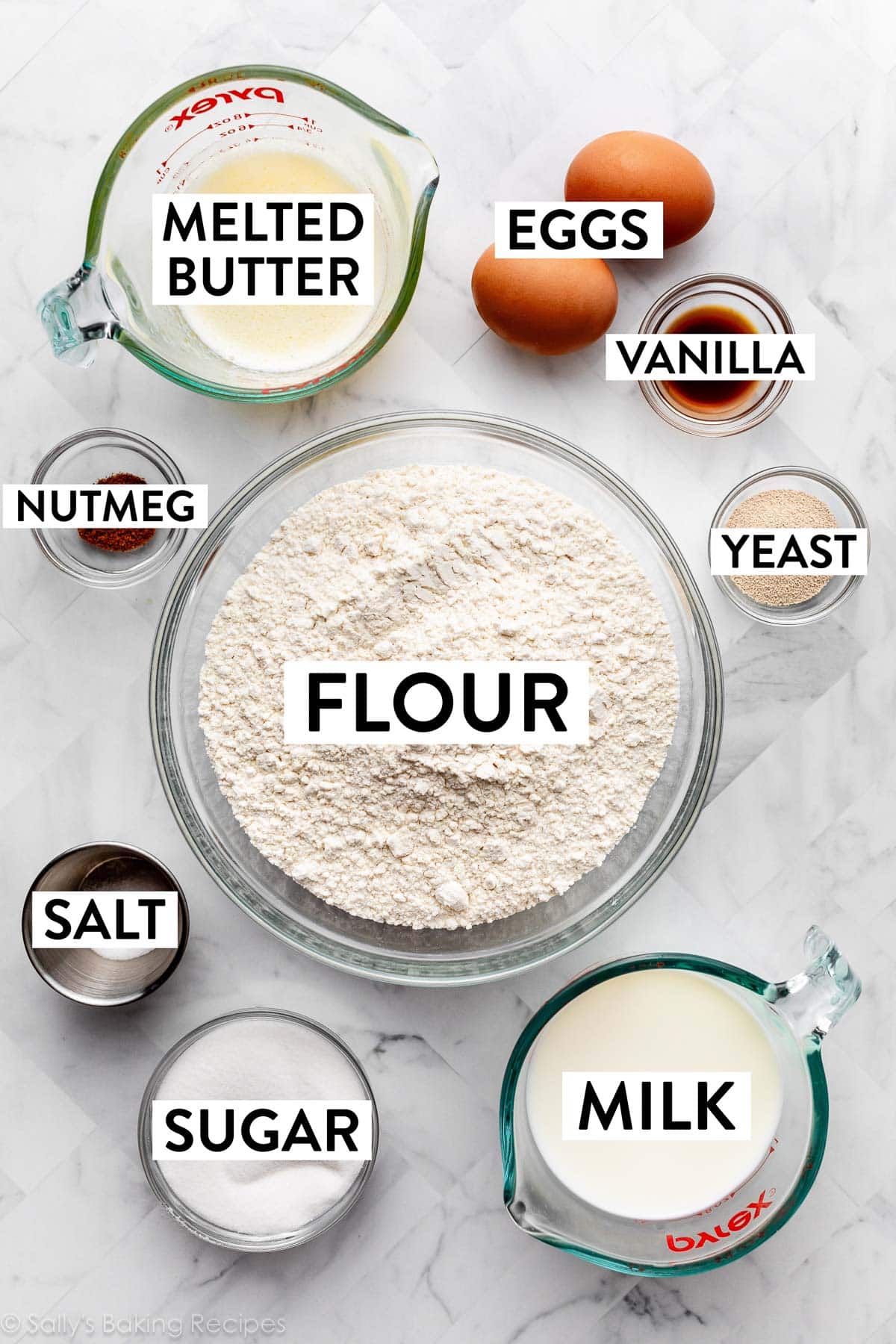
Are You a Yeast Beginner?
Reference this Baking with Yeast Guide whenever you work with baker’s yeast. I include practical answers to all of your common yeast questions.
Overview: How to Make Homemade Glazed Doughnuts
Let me walk you through the process so you understand what you’re doing. Homemade glazed doughnuts seem a little intimidating, but I assure you—they’re really not! I find they’re much easier than, say, homemade bagels and homemade English muffins.
Prepare the dough. The dough comes together with a mixer. You can also make the dough by hand, but it requires a bit of arm muscle. After the dough comes together in the mixing bowl, knead it for 5–7 minutes. If you’re new to yeasted doughs, my how to knead dough post and video can help with this step.
Let the dough rise. In a relatively warm environment, the dough rises in about 90 minutes.
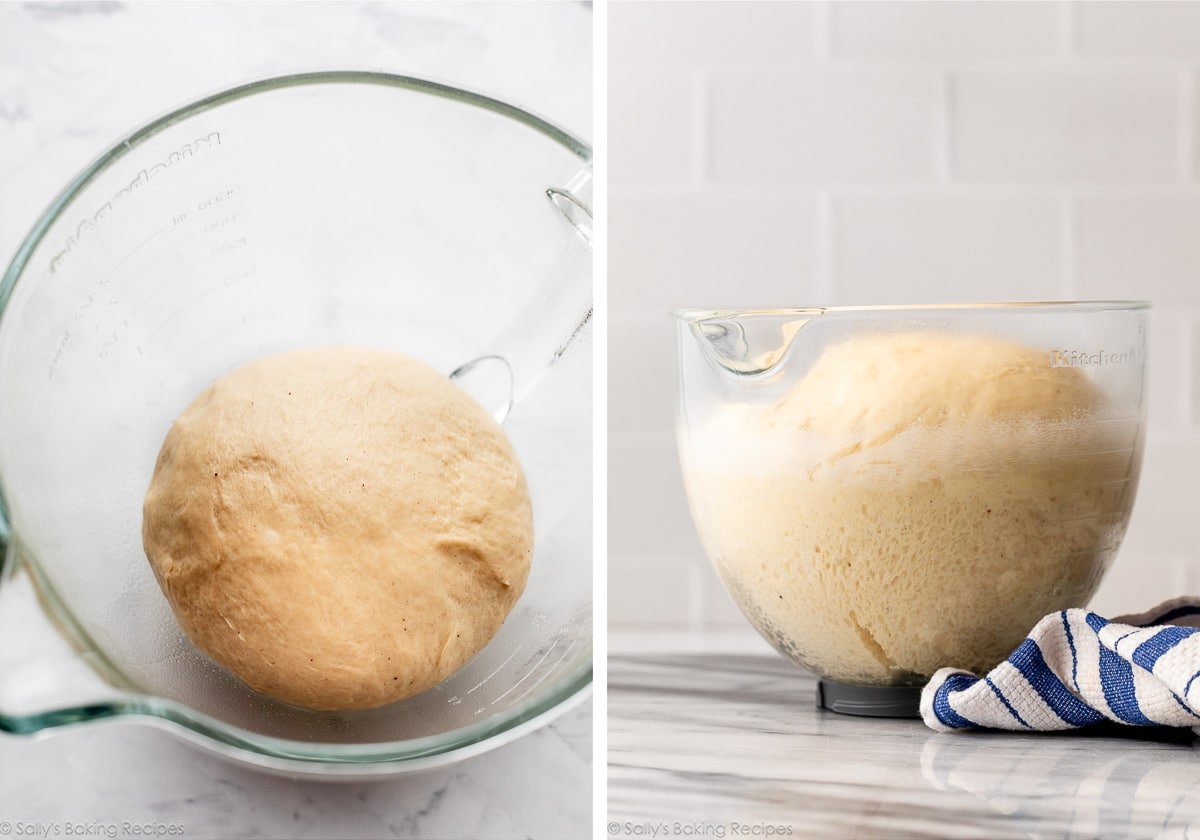
Punch down the dough to release the air.
Roll & cut into doughnuts. Roll the dough out to 1/2-inch thickness. Cut the doughnuts using a 3–3.5-inch doughnut cutter. Line 1 or 2 baking sheets with parchment paper or a silicone baking mat. Place doughnuts (and doughnut holes!) onto the lined baking sheet(s), then lightly cover and allow to rest for 30 minutes as you heat the oil.
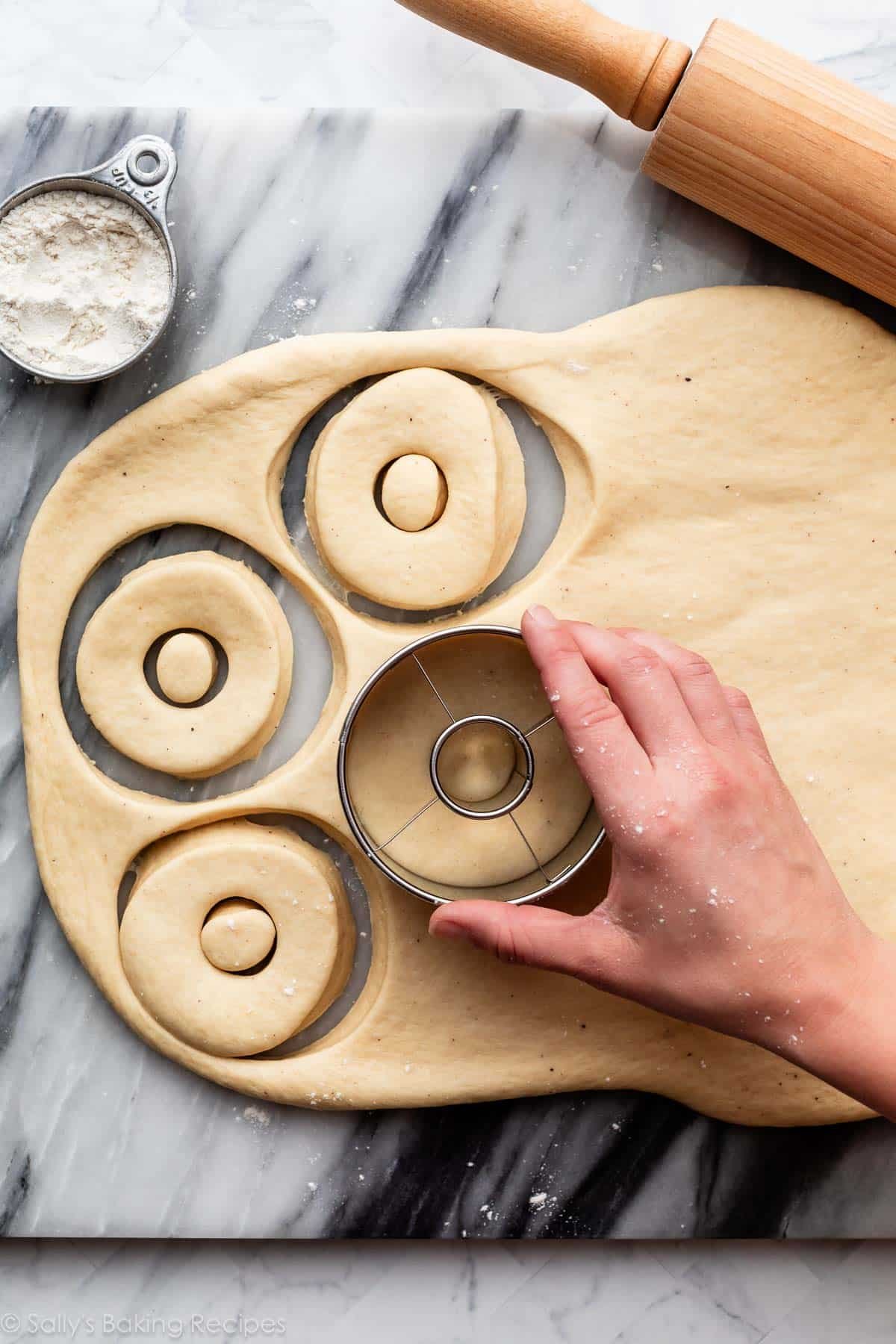
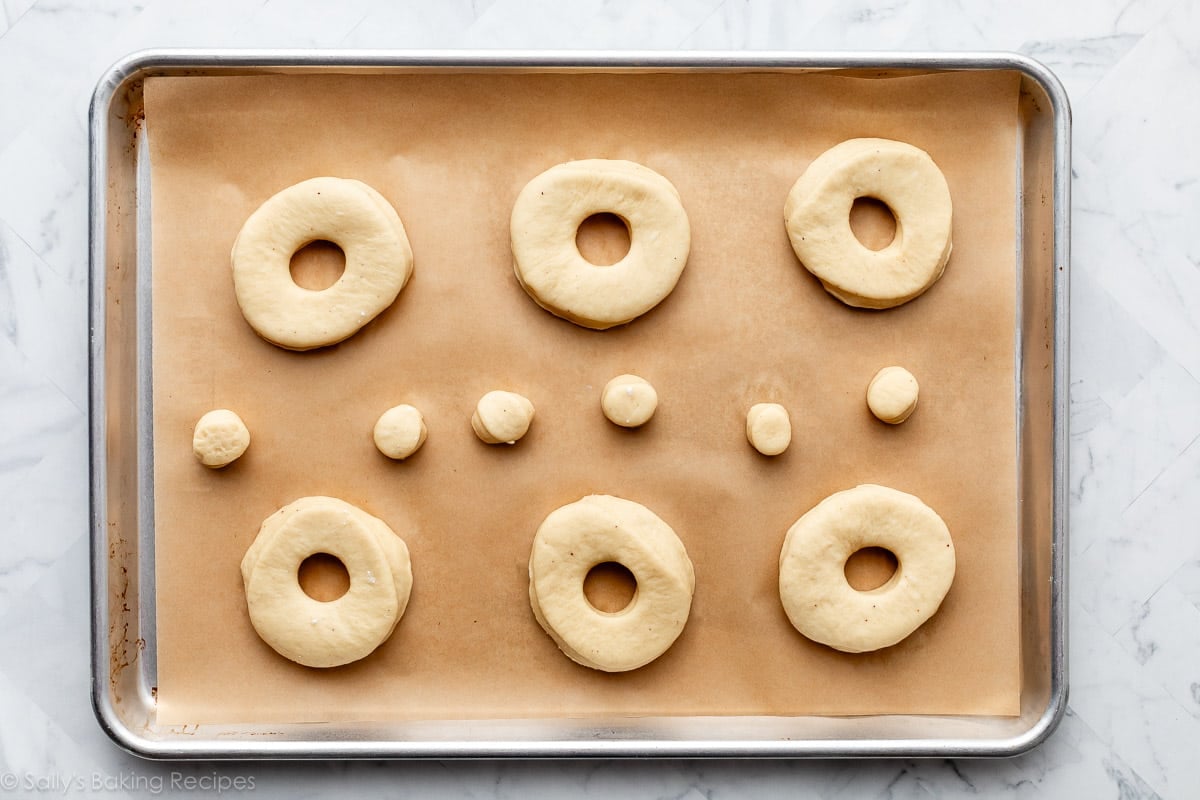
Prepare the oil. Using a heavy-bottomed pot or Dutch oven and an oil thermometer, heat vegetable oil to 375°F (191°C).
Fry the doughnuts. Working with 2–3 doughnuts at a time, cook for 1 minute on each side. Carefully remove from the oil and place onto prepared rack. Repeat with remaining doughnuts. (See my recipe note about making the doughnut holes.)
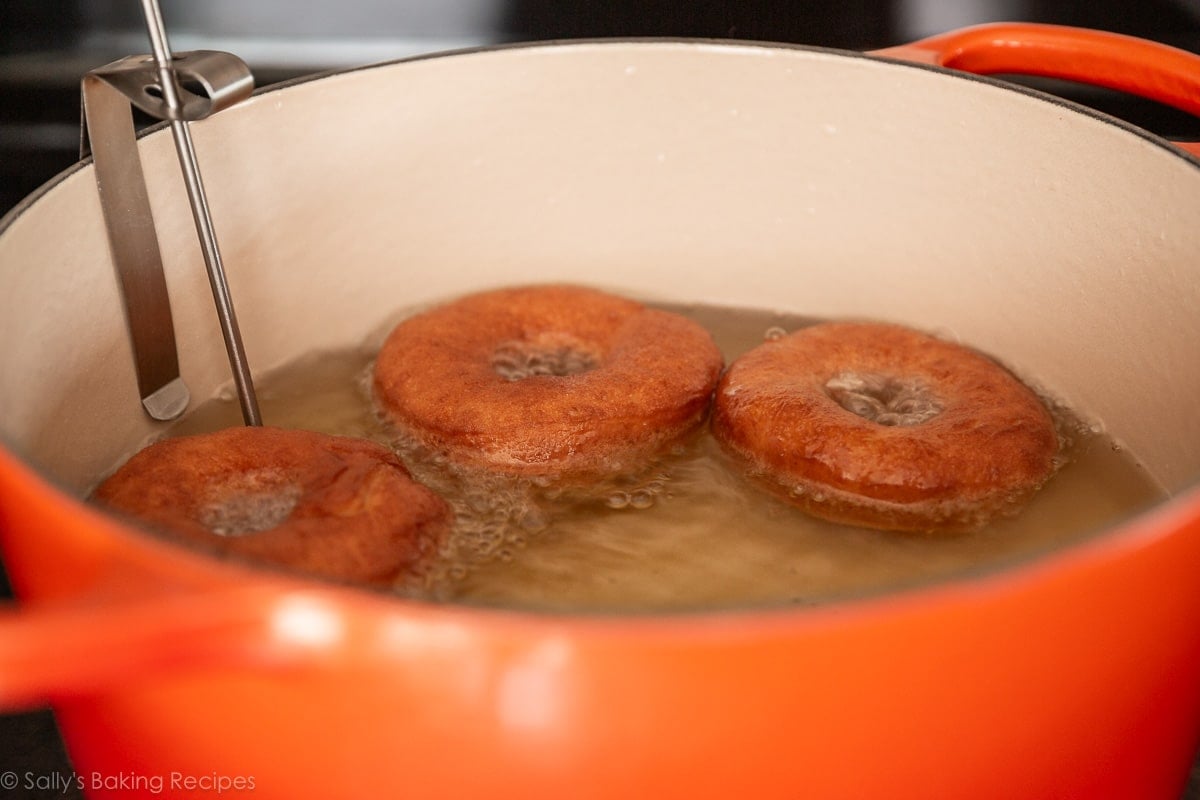
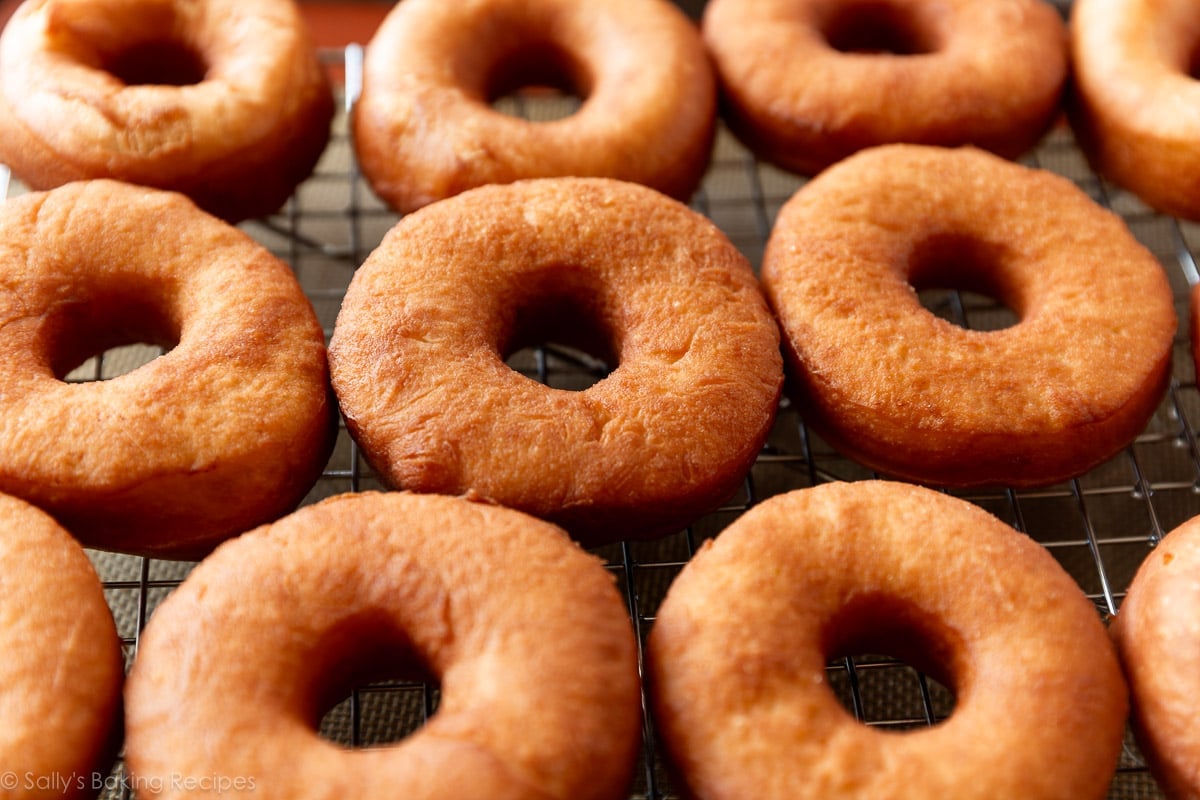
How to Make the Glaze for Donuts
Make a simple 3-ingredient glaze: just milk or cream, confectioners’ sugar, and vanilla extract. This part couldn’t be easier; literally just whisk the 3 ingredients together. Dunk each side of the warm doughnuts into the glaze. The glaze will set in about 20 minutes.
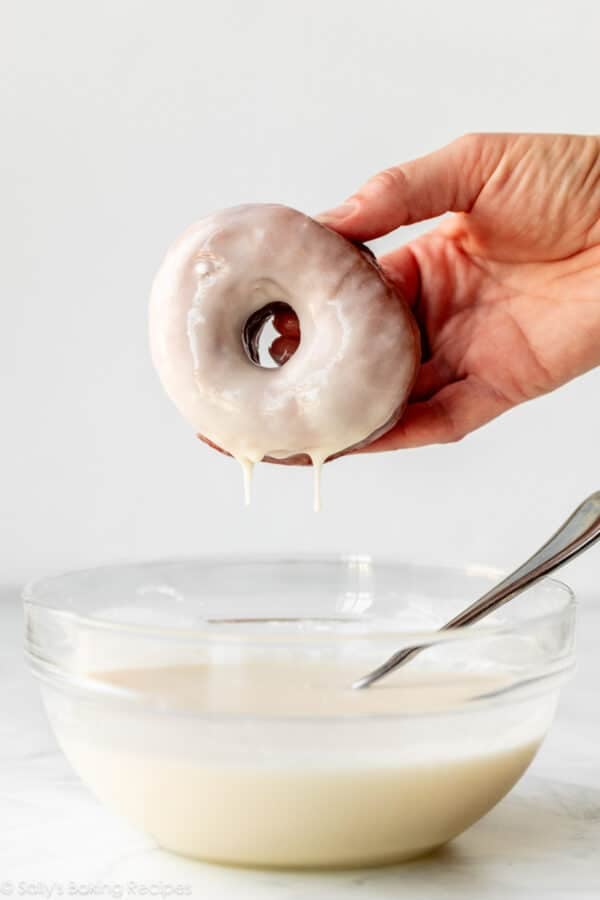
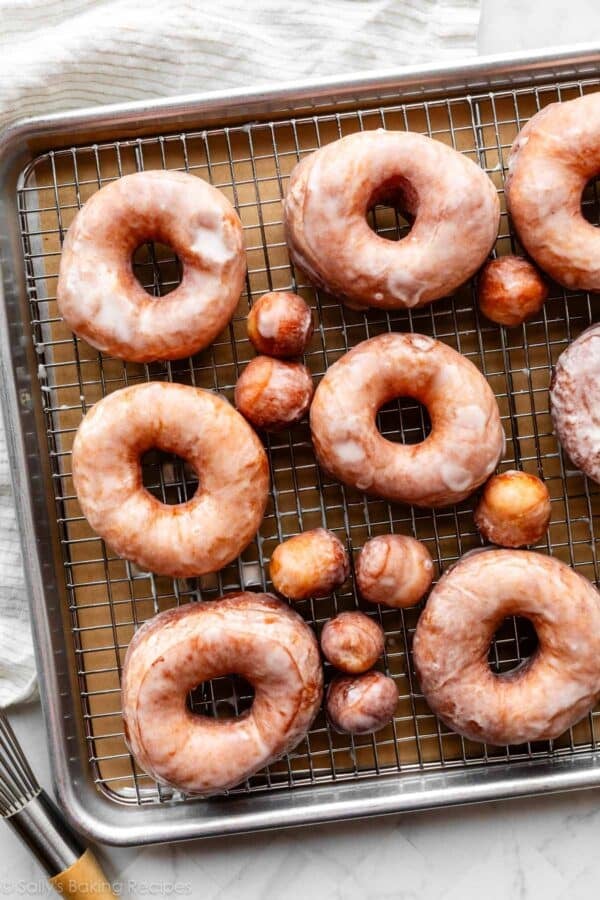
Looking for other flavors? Try my strawberry, chocolate, and vanilla donut frostings or you might enjoy my maple bacon doughnuts!
This Dough Is Best for Frying
I don’t recommend baking this dough—this dough is best for frying in oil. If you’re looking for a baked donut, try crumb cake donuts, pumpkin donuts, cinnamon sugar donuts, or lemon poppy seed donuts instead. Here are all of my donut recipes.
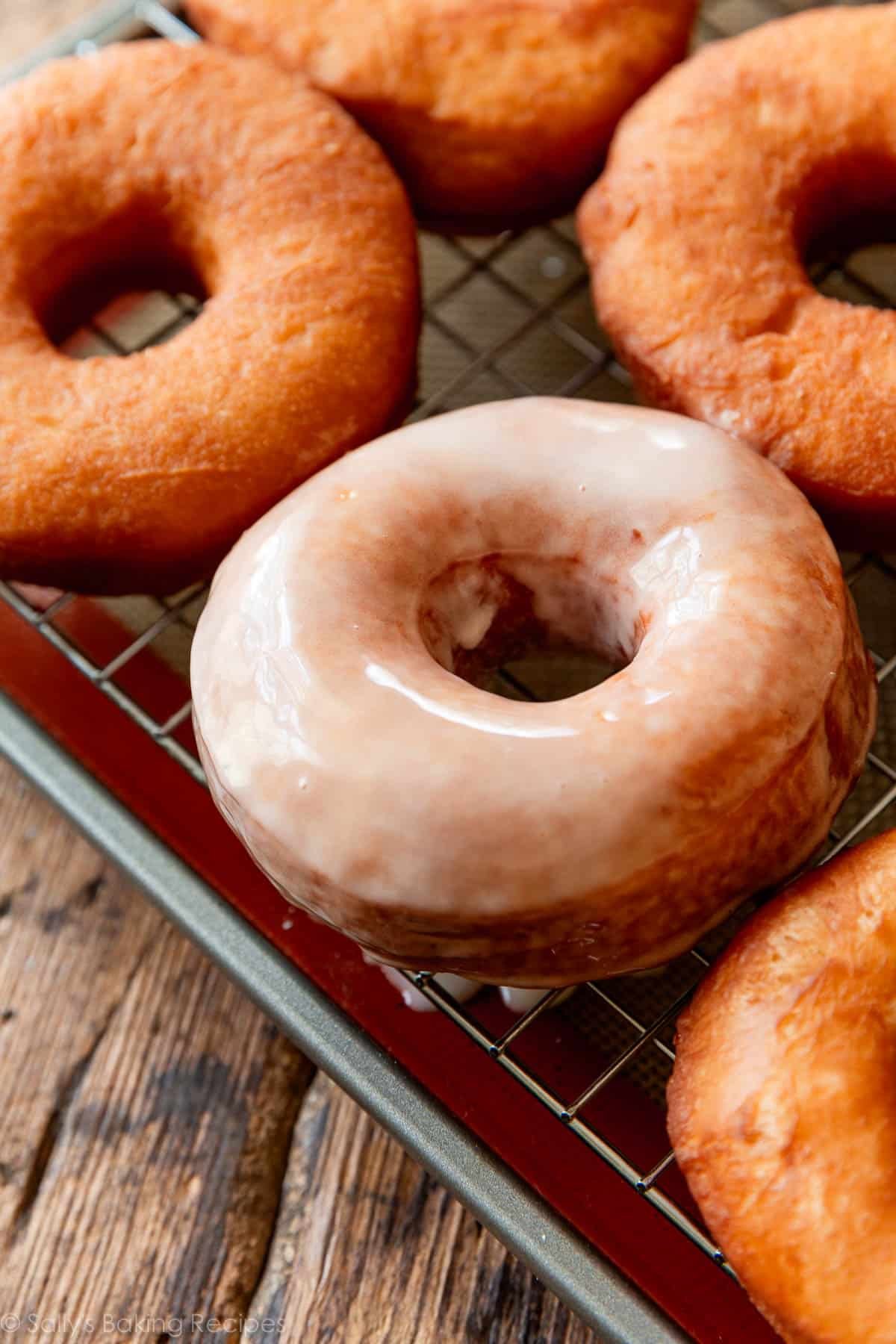
Yes, absolutely. You’ll need a 3-inch biscuit or doughnut cutter without a hole in the center. Use the dough recipe below. Reduce the oil temperature to 350°F (177°C). Fry doughnuts for 1.5–2 minutes on each side, making sure to lower the stove’s temperature if the oil starts to get too hot. Let doughnuts cool for 5–10 minutes before filling. Jams or pastry cream are excellent fillings! Add filling to a piping bag fitted with a long tip such as Ateco 230. Insert the piping tip into the doughnut and fill until the doughnut feels heavy.
This dough is best for frying in oil. You can try using the air fryer, but the donuts will taste more bread-like, and more like baked donuts. For ideal results, I strongly recommend following the recipe.

Homemade Glazed Doughnuts
- Prep Time: 2 hours, 10 minutes
- Cook Time: 10 minutes
- Total Time: 2 hours, 30 minutes
- Yield: 12 donuts and 12 holes
- Category: Breakfast
- Method: Frying
- Cuisine: American
Description
Making homemade glazed doughnuts is easier than you think, but requires a little patience. Ready in about 2.5 hours, these taste like doughnuts from your favorite bakery, but they’re made in the comfort of your own home. For doughnut success, follow my step-by-step photos, helpful success tips, and video tutorial below.
Ingredients
- 1 cup (240ml) whole milk, warmed to about 110°F (43°C)*
- 2 and 1/4 teaspoons (7g) instant or active dry yeast (1 standard packet)*
- 1/3 cup (65g) granulated sugar, divided
- 2 large eggs
- 6 Tablespoons (85g) unsalted butter, melted and slightly cooled
- 1 teaspoon pure vanilla extract
- 1/4 teaspoon ground nutmeg
- 1/2 teaspoon salt
- 4 cups (500g) all-purpose flour (spooned & leveled), plus more as needed
- 1–2 quarts vegetable oil*
Donut Glaze
- 2 cups (240g) confectioners’ sugar, sifted
- 1/3 cup (80ml) heavy cream, half-and-half, or whole milk
- 1/2 teaspoon pure vanilla extract
Instructions
- Prepare the dough: Whisk the warm milk, yeast, and 1 Tablespoon sugar together in the bowl of your stand mixer. Loosely cover and allow to sit for 5–10 minutes until foamy and frothy on top. *If you do not own a stand mixer, you can do this in a large mixing bowl, and in the next step, mix the dough together with a large wooden spoon/silicone spatula. It will take a bit of arm muscle. A hand mixer works, but the sticky dough repeatedly gets stuck in the beaters. Mixing by hand with a wooden spoon or silicone spatula is a better choice.*
- Add the remaining sugar, the eggs, butter, vanilla, nutmeg, salt, and 2 cups (about 250g) flour. Beat on low speed for 1 minute. Scrape down the sides of the bowl with a silicone spatula as needed. Add remaining flour and beat on medium speed until the dough comes together and pulls away from the sides of the bowl, about 2 minutes. If needed, add more flour, 1 Tablespoon at a time, until the dough pulls away from the sides of the bowl. Don’t add too much flour, though. You want a slightly sticky dough.
- Knead the dough: Keep the dough in the mixer and beat for an additional 5-7 full minutes, or knead by hand on a lightly floured surface for 5-7 full minutes. (If you’re new to bread-baking, my How to Knead Dough video tutorial can help here.) If the dough becomes too sticky during the kneading process, sprinkle 1 teaspoon of flour at a time on the dough or on the work surface/in the bowl to make a soft, slightly tacky dough. Do not add more flour than you need because you do not want a dry dough. After kneading, the dough should still feel a little soft. Poke it with your finger—if it slowly bounces back, your dough is ready to rise. You can also do a “windowpane test” to see if your dough has been kneaded long enough: tear off a small (roughly golfball-size) piece of dough and gently stretch it out until it’s thin enough for light to pass through it. Hold it up to a window or light. Does light pass through the stretched dough without the dough tearing first? If so, your dough has been kneaded long enough and is ready to rise. If not, keep kneading until it passes the windowpane test.
- Let Dough Rise: Lightly grease a large bowl with oil or nonstick spray. Place the dough in the bowl, turning it to coat all sides in the oil. Cover the bowl and allow the dough to rise in a relatively warm environment for 1.5–2 hours or until double in size. (For a tiny reduction in rise time, see my answer to Where Should Dough Rise? in my Baking with Yeast Guide.)
- Shape Doughnuts: When the dough is ready, punch it down to release the air. Remove dough from the bowl and turn it out onto a lightly floured surface. Using a rolling pin, roll the dough out until it is 1/2 inch thick. Using a 3–3.5-inch doughnut cutter, cut into doughnuts. Re-roll the scraps and cut more. *If you don’t have a doughnut cutter, you can use 1 large + 1 smaller circle cookie cutter (large should be about 3 and 1/2 inches).
- Line 1 or 2 baking sheets with parchment paper or silicone baking mats. Place doughnuts and doughnut holes on each. Loosely cover and allow to rest for 30 minutes as you heat the oil. They will rise a bit as they rest. Place a cooling rack over another baking sheet.
- Pour oil into a large heavy-duty pot fitted with an oil thermometer. Turn stove on to medium heat. Heat oil to 375°F (191°C). Add 2–3 doughnuts at a time and cook for 1 minute on each side. Carefully remove with a metal slotted spatula or metal slotted spoon. Be sure to lower stove’s temperature if oil temperature is rising; you want it to stay at 375°F (191°C). Wear kitchen gloves if oil is splashing. Place fried doughnuts onto prepared rack. Repeat with remaining doughnuts, then turn off heat.* (See Note for doughnut holes.)
- Make the glaze: Whisk all the glaze ingredients together. Dip each warm doughnut (don’t wait for them to cool!) into the glaze, making sure to coat both sides. Place back onto prepared rack, as excess glaze drips down. After about 20 minutes, the glaze will set.
- Doughnuts are best enjoyed the same day. You can store leftover doughnuts in an airtight container at room temperature or in the refrigerator for another day or two.
Notes
- Freezing Instructions: Prepare recipe through step 5. Freeze shaped doughnuts for up to 3 months. On the day you serve them, let the doughnuts thaw and rest at room temperature for about 4–5 hours. Fry as directed. You can also freeze the fried doughnuts (unglazed). Allow them to cool completely, then freeze for up to 3 months. Thaw in the refrigerator or at room temperature, then reheat as desired (microwave is great) and dunk in freshly made glaze.
- Overnight Instructions: Complete dough through step 3. Instead of allowing to rise in a warm environment in step 4, place the covered dough in the refrigerator overnight (8–12 hours). The next morning, remove from the refrigerator and allow to rise in a warm environment until doubled. The dough will lightly rise in the refrigerator overnight, so the rise the next morning won’t take too long. After rising, continue with step 5.
- Special Tools (affiliate links): Electric Stand Mixer | Large Heavy Bottomed Pot or Dutch Oven | High-Heat Thermometer (I love this thermometer, too) | 3–3.5-inch Doughnut Cutter (I like this one and this one) | Baking Sheets | Silicone Baking Mats or Parchment Paper | Metal Slotted Spatula | Cooling Rack | Glass Mixing Bowl | Whisk
- Doughnut Holes: Add holes to hot oil and fry until golden, about 30 seconds, on each side.
- Milk: Whole milk is a must for the most tender dough—or you can try buttermilk. Lower-fat or nondairy milks work in a pinch, but the doughnuts aren’t as flavorful or rich.
- Yeast: If using an instant yeast, your rise time will be a little shorter. Reference my Baking with Yeast Guide for answers to common yeast FAQs.
- Oil: The amount of oil really depends on how wide or tall your pot is. You want oil to fill about 1/3 of the pot. I use a little more than 1 quart for my 4 and 1/2-quart Dutch oven.
- Leftover Oil: Do not pour used oil down the sink drain. Allow to cool, then pour into an empty container (a funnel is useful here) and discard in the trash or reuse it.
- Adapted from Mark Bittman and Top Pot Doughnuts





















I’ve been looking for an old fashioned (non yeast) donut recipe. Do you have one to share?
Hi L., these apple cider donuts are made without yeast. Let us know if you give them a try!
Really delicious. Recipe was easy to follow. Will make again
I did this recipie and it turned our great! Mt kids loved them! Now they’re requesting them in chocolate! Can I add cocoa powder to this recipie?
Hi Brook, we’re so glad they were a hit! Cocoa powder is a pretty drying ingredient, so it wouldn’t be an even swap with flour. You’d need to make adjustments to the wet ingredients most likely. Let us know if you test anything.
I use all of your recipes!
I tried turning these into apple cider donuts by subbing out 3/4 of the milk with 2 cups of apple cider reduced down to 3/4 of a cup and adding 1 tsp of cinnamon. Results were actually good, but next time I would further increase the apple cider to a start of 3 cups down to 3/4 of a cup, even if it might get syrupy for an extra apple flavor. The coating was 1 cup of sugar to 1 tb of cinnamon, and that was more than enough for the entire batch.
Thus is the best recipe! Thank you so much for sharing it. Everyone that has tried them loves them & can’t believe I made them myself. I’ve been baking more and checking out your recipes. Thanks for the great ideas and recipes.
So good!! The family loved them and kept wanting more. I did find the dough itself wasn’t all that sweet but it works well with the glaze and I think they’d be great with a filling. I’m going to try doing some filled with Nutella or something of the like next time round. We also sprinkled some cinnamon on the glazed dough balls and they were yum!
I love.
The recipe so much
These donuts are delicious!! Fluffy, sweet and crispy on the outside. I made a couple into balls and made jamball donuts which also went down a treat. Will definitely be making these again!
Can these be baked in the oven?
Hi Kristin, no, these are a best made fried. If you’re looking for a baked donut, try crumb cake donuts, pumpkin donuts, cinnamon sugar donuts, or lemon poppy seed donuts instead. Here are all of our donut recipes.
Are donuts still delicious if they were fried the day before?
Hi Rebeka, these are best enjoyed the same day. You can store leftover doughnuts in an airtight container at room temperature or in the refrigerator for another day or two (a few seconds in the microwave helps!) Hope you enjoy these if you give them a try!
Hi! I was wondering if I could rise the dough overnight 6-8 hours in the fridge instead of 2 hours in a warm spot? Thanks!!
Hi Gaby, see recipe notes for overnight rise option. Enjoy!
Looks fantastic. I have a question. Would I be able to use an air fryer instead of deep frying these? I know they probably won’t be as good, but looking at alternative options to help some family that are trying to avoid deep frying.
Hi Bryce, we haven’t tested these in an air fryer, so we’re unsure how well it would work. It may be best to find a recipe specifically formulated to work in an air fryer. Let us know if you do any experimenting, though!
This is the best glazed doughnut recipe ever they taste just like the real thing and are soo easy to make thanks for the recipe!
Am I a baking goddess after making these donuts? Who can say. But I for one could be found dancing around my kitchen shouting expletives of joy as I took my first bite. I don’t think I’ve *ever* had a donut this good in my life. Thank you for the greatest recipe ever!!!
LOVE this recipe. It turned out perfect
Despite the fact I didn’t have cane sugar available and I didn’t have confectioners sugar these doughnuts still came out incredible. I used brown sugar instead for the dough and then to make a glaze I took 1/4 of brown sugar,a tiny amount of milk and some vanilla extract and cooked it down until I had a proper consistency! Topped several of them with some cinnamon and oh my I was impressed, as war my wife and daughter! I also only had salted butter this I skipped adding salt to the dough, and they turned out lovely! I do have one question though, if I wanted to flavor these donuts what would be the best way to go about that?
Hi Cole, we’re so glad they were a hit! We haven’t tested this dough with any other extracts, but that’s where we would start for flavoring. Or you can top them with different donut frostings.
This recipe is fantastic and is now going to be a regular – my husband LOVED them! I have a minor website suggestion for the next time you do an update…can there be a way to make notes on these recipes when we save thm? I would much prefer that than printing them out. Thank you so much for all your delicious hard work. Looking forward to your new cookbook!
We’re so glad they were a hit, Lori! And what a great suggestion. We’ll certainly keep that in mind for the future!
I loved this recipe so much, it was so easy to make. I’m so happy, everything turned perfect and finger-licking good. Everyone in my family loved these doughnuts. Thank you so much!
its nice but idk could be my fault but they taste like pretzels
Could i use the same recipe to stuff them if i dont make holes ?
Hi Ugo, yes, you can use this recipe to make filled doughnuts instead.
These were so good!! They were devoured quickly. I would like to freeze the dough after they are shaped. What is the best method to do this? Thank you!
Hi Samantha, you can freeze the doughnut dough instead of baked doughnuts—-see recipe Notes for details.
Hi! I am going to freeze them after making them. What would you suggest I put them in to freeze them? Ziplock bag? Also, if I do some filled doughnuts, can those be frozen as well in the same manner? Thanks!!
Hi Samantha! A zipped-top bag is usually easiest and takes up the least amount of space. It’s good to get all of the air out of the bag/container after placing the doughnuts inside, too. You can freeze filled doughnuts too, yes!
These donuts were delicious and friends (and my husband) loved them! The dough was beautiful. I subbed 3 cups of pastry flour for 3 of the 4 cups of AP and it was the most supple dough. I had to add probably half a cup more flour to get it to pull away from the bowl but still was awesome. Only critique would be the glaze. It’s very basic and fine but a little too sweet sweet. Next time I’d use my mom’s creamy glaze recipe for them. It has butter and is cooked a little but which gives it a much richer taste that would pair really well with this. Thanks! Your recipes always do well!